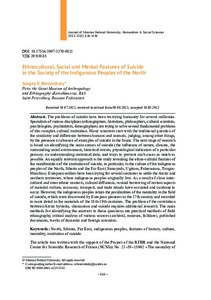Ethnocultural, Social and Mental Features of Suicide in the Society of the Indigenous Peoples of the North
Скачать файл:
URI (для ссылок/цитирований):
https://elib.sfu-kras.ru/handle/2311/143760Автор:
Bereznitsky, Sergey V.
Березницкий, С. В.
Дата:
2021Журнал:
Журнал Сибирского федерального университета. Гуманитарные науки. Journal of Siberian Federal University. Humanities & Social Sciences; 2022 15 (5)Аннотация:
The problems of suicide have been worrying humanity for several millennia. Specialists of various disciplines (ethnographers, historians, philosophers, cultural scientists, psychologists, psychiatrists, demographers) are trying to solve several fundamental problems of this complex cultural institution. Many scientists start with the traditional question of the similarity and difference between humans and animals, judging, among other things, by the presence or absence of examples of suicide in the fauna. The next stage of research is based on identifying the main causes of suicide (the influence of nature, climate, the surrounding social environment, historical events, physiological indicators of a particular person), on understanding statistical data, and ways to prevent such cases as much as possible. An equally relevant approach is the study revealing the ethno-cultural features of the manifestation of the institution of suicide, in particular, in the culture of the indigenous peoples of the North, Siberia and the Far East (Samoyeds, Ugrians, Paleoasians, Tungus-Manchus). European settlers have been trying for several centuries to settle the Arctic and northern territories, where indigenous peoples originally live. As a result of close inter-cultural and inter-ethnic contacts, cultural diffusions, mutual borrowing of certain aspects of material culture, economy, transport, and trade rituals have occurred and continue to occur. However, the indigenous peoples retain the peculiarities of the mentality in the field of suicide, which were discovered by European pioneers in the 17th century and recorded in more detail in the materials of the 18th‑19th centuries. The problem of the correlation between Arctic hysteria, shamanism and suicide requires additional research. The main methods for identifying the answers to these questions are practical methods of field ethnography, critical analysis of various sources (archival, museum, folklore), published documents, works of domestic and foreign scientists Проблема суицида всегда была и остается актуальной. По данным
Всемирной организации здравоохранения, современная Россия лидирует по количеству
самоубийств и занимает второе место в мире после Литвы. Этому вопросу посвящено
огромное количество научных трудов. Ученых волнуют статистика и причины
самоубийств, их социальные последствия, реакция общественности и властей. Не менее
важным направлением представляется исследование сущности, этнокультурных,
ментальных особенностей института суицида в обществе коренных народов Севера,
Сибири и Дальнего Востока. Для решения поставленной цели использованы
практические и теоретические методы этнографической науки: опрос информантов;
историко-типологический
анализ, позволяющий исследовать стадиальные явления,
тип культуры в рамках относительно замкнутых областей (бассейн Амура, Сахалин,
Камчатка, Чукотка); историко-диффузионный для решения проблем этнокультурных
контактов коренных народов Севера с соседними и переселенческими этносами;
историко-генетический
для выявления проблем трансляции этнокультурных ценностей.
Данные методы, а также анализ архивных источников позволили сделать вывод
о кардинальном отличии менталитета европейских этносов и коренных народов северных
регионов в сфере осмысления суицида, его мотивов, причин, связи этого сложного
явления с этносоциальным окружением, с верованиями, ритуалами жизненного цикла

